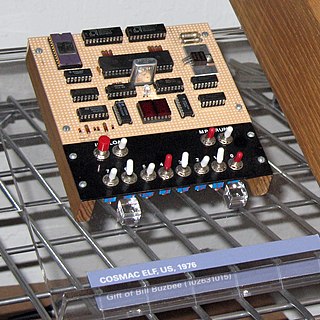The RCA CDP1861 was an integrated circuit Video Display Controller, released by the Radio Corporation of America (RCA) in the mid-1970s as a support chip for the RCA 1802 microprocessor. The chip cost in 1977 amounted to less than US$20. [1]
The CDP1861 was manufactured in a low-power CMOS technology, came in a 24-pin DIP (Dual in-line package), and required a minimum of external components to work. In 1802-based microcomputers, the CDP1861 (for the NTSC video format, CDP1864 variant for PAL), used the 1802's built-in DMA controller to display black and white (monochrome) bitmapped graphics on standard TV screens. The CDP1861 was also known as the Pixie graphics system, display, chip, and video generator, [2] especially when used with the COSMAC ELF microcomputer. Other known chip markings for the 1861 are TA10171, TA10171V1 and a TA10171X, which were early designations for "pre-qualification engineering samples" and "preliminary part numbers", although they have been found in production RCA Studio II game consoles and Netronics Elf microcomputers. [3] The CDP1861 was also used in the Telmac 1800 and Oscom Nano microcomputers.
The 1861 chip could display 64 pixels horizontally and 128 pixels vertically, though by reloading the 1802's R0 DMA (direct memory access) register via the required 1802 software controller program and interrupt service routine, the resolution could be reduced to 64×64 or 64×32 to use less memory than the 1024 bytes needed for the highest resolution (with each monochrome pixel occupying one bit) or to display square pixels. A resolution of 64×32 created square pixels and used 256 bytes of memory (2K bits). This was the usual resolution for the Chip-8 game programming system. Since the video graphics frame buffer was often similar or equal in size to the memory size, it was not unusual to display your program/data on the screen allowing you to watch the computer "think" (i.e. process its data). Programs which ran amok and accidentally overwrote themselves could be spectacular.
The CDP1862 Color Generator Circuit IC, an 1861 companion chip, could be used to generate limited color graphics.
Due to the discontinuation of the 1861 and its rarity, in 2004 a fully functional analogue called the Spare Time Gizmos STG1861 was made for use with the newly designed and produced ELF 2000 (Elf2K) computer. [4] It is made in the form of a small printed circuit board (PCB) with two small programmable logic devices, two simple TTL chips, and a 24-pin DIP connector for mounting in place of the original chip.

The Apple II is an 8-bit home computer and one of the world's first highly successful mass-produced microcomputer products. It was designed primarily by Steve Wozniak; Steve Jobs oversaw the development of Apple II's foam-molded plastic case and Rod Holt developed the switching power supply. It was introduced by Jobs and Wozniak at the 1977 West Coast Computer Faire, and marks Apple's first launch of a personal computer aimed at a consumer market—branded toward American households rather than businessmen or computer hobbyists.

The Original Chip Set (OCS) is a chipset used in the earliest Commodore Amiga computers and defined the Amiga's graphics and sound capabilities. It was succeeded by the slightly improved Enhanced Chip Set (ECS) and greatly improved Advanced Graphics Architecture (AGA).
A blitter is a circuit, sometimes as a coprocessor or a logic block on a microprocessor, dedicated to the rapid movement and modification of data within a computer's memory. A blitter can copy large quantities of data from one memory area to another relatively quickly, and in parallel with the CPU, while freeing up the CPU's more complex capabilities for other operations. A typical use for a blitter is the movement of a bitmap, such as windows and fonts in a graphical user interface or images and backgrounds in a 2D video game. The name comes from the bit blit operation of the 1973 Xerox Alto, which stands for bit-block transfer. A blit operation is more than a memory copy, because it can involve data that's not byte aligned, handling transparent pixels, and various ways of combining the source and destination data.

The DECstation was a brand of computers used by DEC, and refers to three distinct lines of computer systems—the first released in 1978 as a word processing system, and the latter two both released in 1989. These comprised a range of computer workstations based on the MIPS architecture and a range of PC compatibles. The MIPS-based workstations ran Ultrix, a DEC-proprietary version of UNIX, and early releases of OSF/1.

The Netronics ELF II was an early microcomputer trainer kit featuring the RCA 1802 microprocessor, 256 bytes of RAM, DMA-based bitmap graphics, hexadecimal keypad, two digit hexadecimal LED display, a single "Q" LED, and 5 expansion slots. The system was developed and sold by Netronics Research and Development Limited in New Milford, CT, USA.

The COSMAC is an 8-bit microprocessor family introduced by RCA. It is historically notable as the first CMOS microprocessor. The first production model was the two-chip CDP1801R and CDP1801U, which were later combined into the single-chip CDP1802. The 1802 represented the majority of COSMAC production, and today the entire line is known simply as the RCA 1802.

Alphanumeric Television Interface Controller (ANTIC) is an LSI ASIC dedicated to generating 2D computer graphics to be shown on a television screen or computer display. Under the direction of Jay Miner, the chip was designed in 1977-1978 by Joe Decuir, Francois Michel, and Steve Smith for the Atari 8-bit family of home computers first released in 1979 and was patented by Atari, Inc. in 1981. ANTIC is also used in the Atari 5200 video game system released in 1982, which shares most of the same hardware as the 8-bit computers.

The COSMAC VIP (1977) was an early microcomputer that was aimed at video games. Essentially, it was a COSMAC ELF with a supplementary CDP1861/CDP1864 video display chip. For a price of US$275, it could be purchased from RCA by mail order. It came in kit form, and had to be assembled. Its dimensions were 22 x 28 cm, and it had a RCA 1802 processor; along with a crystal clock operating at 1.76 MHz. It had 2 KB of RAM, which could be expanded to 4 KB on board, and 32 KB via an expansion slot. Its 5V DC CDP18S023 power supply had an output of 600 mA. I/O ports could be added to connect to sensors, interface relays, an ASCII keyboard, or a printer.

The COSMAC Elf was an RCA 1802 microprocessor-based computer described in a series of construction articles in Popular Electronics magazine in 1976 and 1977. Through the back pages of electronics magazines, both Netronics and Quest Electronics offered low-priced, enhanced kits that were based on this design. The system was a very early single-board personal computer. It was operated without built-in ROMs and programs were entered directly with help of the CPU integrated DMA using 8 toggle switches and an Input push button.

The Motorola 6845, or MC6845, was a display controller that was widely used in 8-bit computers during the 1980s. Originally intended for designs based on the Motorola 6800 CPU and given a related part number, it was more widely used alongside various other processors, and was most commonly found in machines based on the Zilog Z80 and MOS 6502.

CHIP-8 is an interpreted programming language, developed by Joseph Weisbecker. It was initially used on the COSMAC VIP and Telmac 1800 8-bit microcomputers in the mid-1970s. CHIP-8 programs are run on a CHIP-8 virtual machine. It was made to allow video games to be more easily programmed for these computers.

The RCA Studio II is a home video game console made by RCA that debuted in January 1977. The graphics of Studio II games were black and white and resembled those of earlier Pong consoles and their clones. The Studio II also did not have joysticks or similar game controllers but instead used two ten-button keypads that were built into the console itself. The console was capable of making simple beep sounds with slight variations in tone and length. The Studio II included five built-in games.

A video display controller or VDC is an integrated circuit which is the main component in a video signal generator, a device responsible for the production of a TV video signal in a computing or game system. Some VDCs also generate an audio signal, but that is not their main function.
The Firefly was a shared memory asymmetric multiprocessor workstation, developed by the Systems Research Center, a research organization within Digital Equipment Corporation. The first version built contained up to seven MicroVAX 78032 microprocessors. The cache from each of the microprocessors kept a consistent view of the same main memory using a cache coherency algorithm, the Firefly protocol. The second version of the Firefly used faster CVAX 78034 microprocessors. It was later introduced as a product by DEC as VAX-3520/3540 and called 'Firefox'.

The Dick Smith Super-80 was a Zilog Z80 based kit computer developed as a joint venture between Electronics Australia magazine and Dick Smith Electronics. It was presented as a series of construction articles in Electronics Australia magazine's August, September and October 1981 issues.
The Apple II graphics were composed of idiosyncratic modes and settings that could be exploited. This graphics system debuted on the original Apple II, continued with the Apple II Plus and was carried forward and expanded with the Apple IIe, Enhanced IIe, IIc, IIc Plus and IIGS.

Cromemco's Dazzler is a graphics card for S-100 bus computers. Released in 1976, it is the first commercial color bit-mapped graphics card available for microcomputers. Multiple Dazzler cards could be installed in a single machine and synced together, a feature which could, with minor modification, be used to genlock. Genlocked Dazzler cards drove ColorGraphics Weather Systems displays that generated most of the weather imagery seen on US television in the early 1980s.
In addition to the Amiga chipsets, various specially designed chips have been used in Commodore Amiga computers that do not belong to the 'Amiga chipset' in a tight sense.
Joseph A. Weisbecker was an early microprocessor and microcomputer researcher, as well as a gifted writer and designer of toys and games. He was a recipient of the David Sarnoff award for outstanding technical achievement, recipient of IEEE Computer magazine's "Best Paper" award, as well as several RCA lab awards for his work.